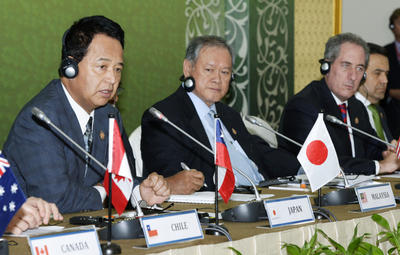Australia’s participation in the ASEAN+6 Regional Comprehensive Economic Partnership (RCEP) and the US-centred Trans-Pacific Partnership (TPP) present a significant opportunity to re-shape the regional and global trade agenda. The Asia Pacific region and the global trading system are in a state of fluidity and there is uncertainty about the best way to take trade and investment reform forward. The large number of FTAs signed to date have not brought significant commercial or domestic reform in the region and, with the difficulties in concluding the Doha Round, the hiatus in trade reform puts weight on making the most of these region-wide trade initiatives, using them to prosecute reform in the region and to re-shape the global trading system.
The rapid growth of trade and investment in East Asia was driven by unilateral liberalisation and opening up. Australia was a leader in this and APEC was the forum that promoted concerted unilateral liberalisation, including a massive liberalisation by China in the lead up to its accession to the WTO. Australia’s leadership in the creation of APEC, the Information Technology Agreement, and more recently the environmental goods agreement in APEC was pursued in the past in tandem with Japan and middle powers in the region. China was not earlier at a stage where it was able or willing to take an active leadership role: it might well be ready now to join a coalition for trade reform, although it is not yet a party to the TPP negotiations.
In Australia the immediate focus appears to be on concluding outstanding FTAs with key partners in the region quickly. There is a much bigger agenda of national reform playing into the appetite for national reform across Asia.
Beyond improving commercial and investment opportunities in the Asia-Pacific region for Australian businesses, Australia’s core interest is in shaping the TPP so that, over time, it is more likely that large emerging economies such as Indonesia, China and India can join. These countries are among Australia’s most important trade, investment and political partners, and it is crucial that every opportunity is made to bring them into any agreement over time – even if it is challenging to convince some existing TPP members of the imperative. The goal of a high standard agreement would be to have developing countries commit to standards they aspire to in reasonable timeframes, not to exclude them and punish them for not starting with developed country standards immediately.
The package currently on the table in TPP has very little in it for Australia. An outcome that does not go much further on agriculture and secure commercially meaningful access in key markets for Australian services providers and investors would be a difficult economic and political sell. As the negotiations approach the end-game, Australia needs to push hard to ensure that countries’ offers improve sufficiently in these areas and to protect its interests in new disciplines, such as intellectual property. Or it needs to opt out, in its own national interests.
China and other non-members of TPP are absolutely integral parts of Asian supply chains which are driving economic integration and growth in East Asia and globally. It is through these supply chains that the newer emerging economies in Southeast Asian and South Asia can join the globalisation process.
RCEP involves more negotiating members than the TPP and all Asia’s main economies including China and India are partners. RCEP is a way forward with economic cooperation, underpinned by the ASEAN + framework, despite all the region’s political problems. Bringing together the ASEAN+1 trade agreements with Japan, China, South Korea and India will be difficult even with ASEAN as the fulcrum and countries like Australia playing an active and constructive role. Pursuing negotiations in the same manner as the TPP or as in traditional FTAs will mean a long, drawn-out, unproductive process.
A more productive strategy is to see a streamlined economic cooperation agreement as one of the several steps that will be needed for an RCEP that embraces a comprehensive program of regional economic integration and development. That would parallel the strategy for creating the ASEAN Economic Community (AEC). Upgrading of the ASEAN Free Trade Agreement (AFTA) of the 1990s to the more comprehensive ASEAN Trade In Goods Agreement (ATIGA) was one of the first steps taken to implement the AEC, alongside a broader program including work to implement the Master Plan for ASEAN Connectivity. Negotiating an innovative umbrella FTA among RCEP participants could be pursued in parallel with the other steps needed to achieve deeper economic integration and regional development goals.
RCEP participants should not have to wait until a single undertaking on trade liberalisation by all participants and all new rules are agreed upon before taking up the other opportunities for beneficial economic integration. It can seek to achieve a significant initial down-payment on trade liberalisation and lock in progress towards ambitious end-point goals.
In this conception, the most effective strategy to achieve these ambitions on the timeline that has been determined will be a creative combination of agreed and binding targets for 2025; initial commitments (the down payment) negotiated by 2015; and thereafter the legally disciplined cooperation and negotiations to implement these targets by all members carried forward as from 2015 within a newly established institutional framework.
A strategy along these lines (open to US participation) would address worries that are widely shared across the region. It could make it easier to involve countries like India and other less developed countries in Southeast Asia; contribute to connecting South Asia with East Asia; deliver major and successful mega-regional cooperation initiative; and represent a significant innovation in the global trading system.
It can also present a way forward for dialogue (in the G20) on WTO reform.
Peter Drysdale is co-editor of East Asia Forum and head of the East Asian Bureau of Economic Research.

